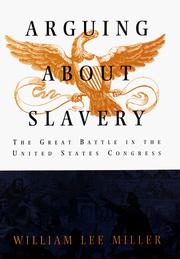Check nearby libraries
Buy this book

Here is the United States Congress in the 1830s, grappling (or trying unsuccessfully to avoid grappling) with the gravest moral dilemma inherited from the framers of the Constitution. Here is the concept (and reality) of the ownership of human beings confronting three of the most powerful ideas of the time: American republicanism, American civil liberties, American representative government.
This book re-creates an episode in our past, now forgotten, that once stirred and engrossed the nation: the congressional fight over petitions against slavery.
The action takes place in the House of Representatives. Beginning in 1835, a new flood of abolitionist petitions pours into the House. The powers-that-be respond with a gag rule as their means of keeping these appeals off the House floor and excluding them from national discussion. A small band of congressmen, led by former president John Quincy Adams, battles against successive versions of the gag and introduces petitions in spite of it.
Then, in February 1837, Adams raises the stakes by forcing the House to cope with what he calls "The Most Important Question to come before this House since its first origin": Do slaves have the right of petition?
When the Whigs take over in 1841, some expect the gag rule to be repudiated, but instead it is made permanent. A small insurgent group of Whigs, collaborating with Adams, opposes party policy and makes opposition to slavery their top priority. They constitute the seedbed for the formation of the Republican Party which will be, in the next decade, the beginning of the end of slavery.
Congressional leaders try to censure Adams, and his well-publicized "trial" in the House brings the entire matter to the nation's attention. The anti-Adams effort fails, and finally, after nine years of persistent support of the right of petition, Adams succeeds in defeating the gag rule.
- Throughout, one can see the gradual assembling not only of the political but also of the moral and intellectual elements for the ultimate assault on American slavery. When John Quincy Adams dies, virtually on the House floor, the young congressman Abraham Lincoln is sitting in the chamber.
Check nearby libraries
Buy this book

Previews available in: English
Subjects
Politics and government, Freedom of debate, Slavery, United States, United States. Congress, History, Adams, John Quincy, 1767-1848, United states, congress, United states, politics and government, 1815-1861, Slavery, united states, history, Liberty, Human Rights, Freedom, Politique et gouvernement, Esclavage, Histoire, Liberté, Sklaverei, Abschaffung, Slavernij, Parlementaire debatten, Het Congres, Comptes rendus des débats, Geschichte 1835-1844, USA Congress, USA, États-Unis. Congress, États-UnisPlaces
United States, Washington DCTimes
1815-1861, 19th centuryShowing 3 featured editions. View all 3 editions?
| Edition | Availability |
|---|---|
|
1
Arguing about Slavery: John Quincy Adams and the Great Battle in the United States Congress
January 12, 1998, Vintage, Vintage Books
Paperback
in English
0679768440 9780679768449
|
zzzz
Libraries near you:
WorldCat
|
|
2
Arguing About Slavery: the great battle in the United States Congress
1996, A.A. Knopf, INC.
Hardcover
in English
- 1st ed.
0394569229 9780394569222
|
aaaa
Libraries near you:
WorldCat
|
|
3
Arguing aboutslavery: the great battle in the United States Congress
1996, A.A. Knopf
in English
0394569229 9780394569222
|
cccc
Libraries near you:
WorldCat
|
Book Details
Edition Notes
Includes bibliographical references (p. [545]-553) and index.
Classifications
The Physical Object
ID Numbers
Source records
Scriblio MARC recordCollingswood Public Library record
Ithaca College Library MARC record
Internet Archive item record
Excerpts
Community Reviews (0)
Feedback?| July 18, 2024 | Edited by MARC Bot | import existing book |
| May 27, 2022 | Edited by ImportBot | import existing book |
| October 8, 2021 | Edited by ImportBot | import existing book |
| February 28, 2020 | Edited by MARC Bot | remove fake subjects |
| December 10, 2009 | Created by WorkBot | add works page |












